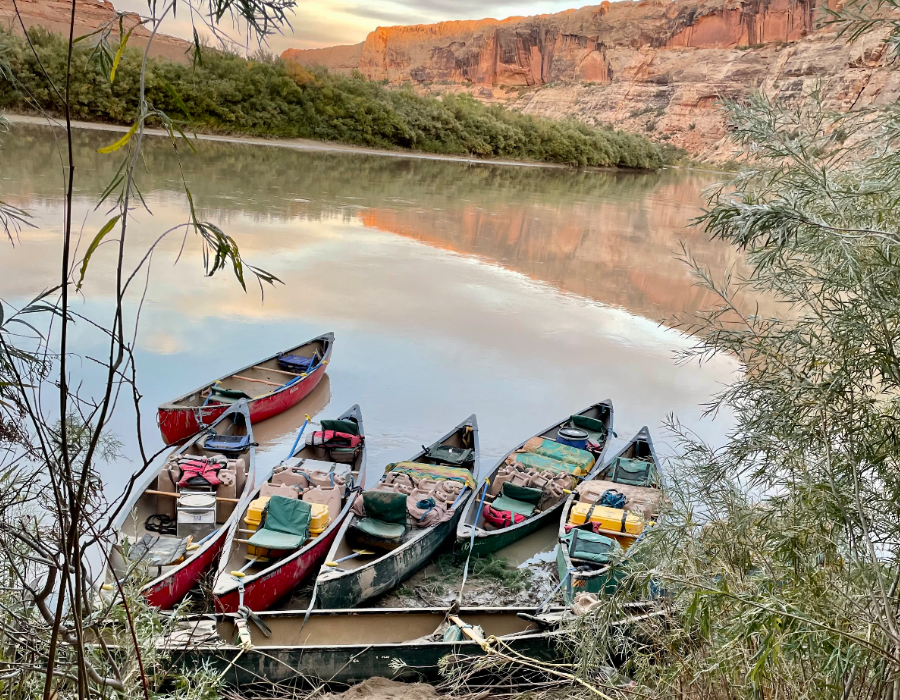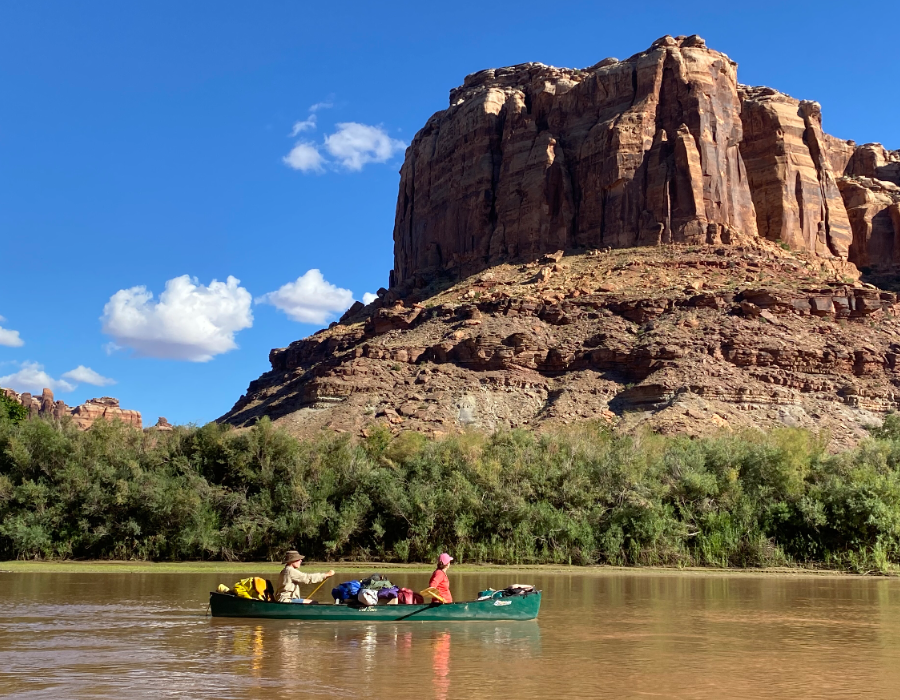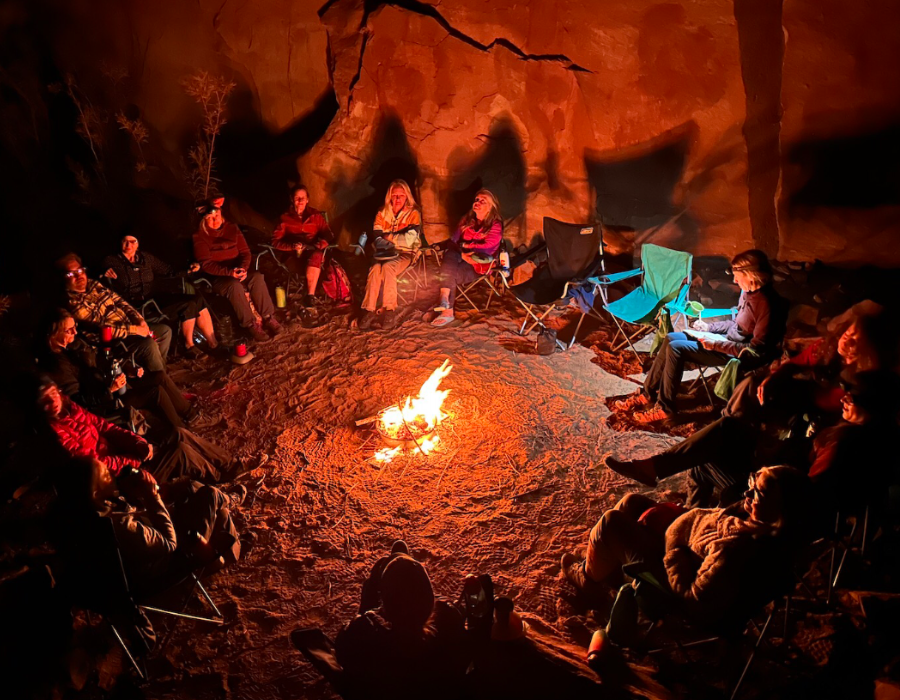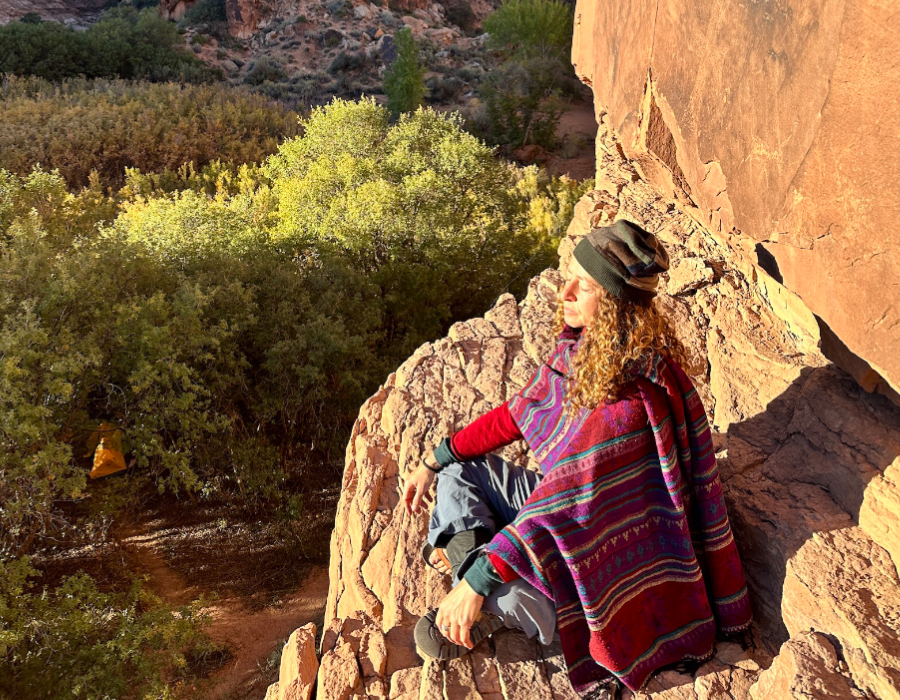By Chana Widawski
“Stalk a story,” echoed the invitation from ecophilosopher, cultural ecologist, and guest river guide David Abram, as our group rested on the soft earth, shaded from the brilliant rays glistening on the flowing Green River we had just peacefully paddled and emerged from. Gazing at the blue skies and storied Labyrinth Canyon walls, whose grandeur secluded our River’s Path group from the distractions and destructions of modern life, I was elated to return to the natural environment where I first encountered sacrednicity, an extraordinary and spiritual embodied experience, illuminating our interconnectedness with the “more than human world.”
 Utah’s prodigious Labyrinth Canyon offers unrivaled environmental magnificence, geological wonder, radiant light, magical bird song, and slow river flow, a perfect concoction for nature nourishment and needed pause from our overcharged lives. While all that wonder is enough to satisfy a craving for nature’s cradle, if we are truly open, we can experience something much deeper and more magical, with impact far beyond expectation.
Utah’s prodigious Labyrinth Canyon offers unrivaled environmental magnificence, geological wonder, radiant light, magical bird song, and slow river flow, a perfect concoction for nature nourishment and needed pause from our overcharged lives. While all that wonder is enough to satisfy a craving for nature’s cradle, if we are truly open, we can experience something much deeper and more magical, with impact far beyond expectation.
This has been my greatest lesson from paddling the Green River, guided by transformational canoe guide Lauren Bond, the land herself, and the renowned guest guides, like Abram, that Bond invites to be a part of her excursions. From accidental viral poet John Roedel and multi-dimensional naturalist and healing artist Sarah West, to Swedish singer Fia, nature writer Craig Childs, and famed musicians Mamuse, Bond’s trips often feature high-caliber guest guides — just one facet of her tours that makes The River’s Path unique. Powerful stories and lessons from these acclaimed thinkers, singers, and doers remain alive in this special canyon, blending with our own stories and those before us, making for an unparalleled amalgam of richness.
Breathing the canyon’s desert air, I felt worlds away from the familiar smells and sights of autumn in the Northeast, where I grew up. As calendar events no longer necessarily align with earth-based rituals we are accustomed to, whether due to erratic weather patterns from our warming world or our own choices — like choosing to canoe a river in the desert Southwest during Sukkot (a harvest holiday which I typically celebrate amid colorful autumn leaves) — I am energized by the synergies that present themselves. They magnify a timeless interrelation of culture, humanity, and ecology that many are too distracted to experience. Although I felt prepared and excited at the journey that lay ahead of me, as I paddled effortlessly and gazed in awe at the otherworldly canyon, I still could have never imagined all that I would experience.
 That sunny autumn day, I admittedly had lost complete track of the calendar. I had spent the previous days soaking in hot springs, hiking mountains, excitedly packing up for the canoe trip, and living very much in the present moment. Paddling together with a motley crew of participants — some with camping and canoeing experience, some complete newbies — spanning a wide range of ages, abilities, and life experience from across the country and even Canada, I became further lost in time as I got to know my adventure-mates, and we marveled our heavenly surroundings. The canoes of our colorful flotilla, loaded up with personal gear, tubs full of delicious meal supplies, and even a “groover” (one of our most important provisions, set up at each night’s campsite for private bathroom time), all caught up with each other.
That sunny autumn day, I admittedly had lost complete track of the calendar. I had spent the previous days soaking in hot springs, hiking mountains, excitedly packing up for the canoe trip, and living very much in the present moment. Paddling together with a motley crew of participants — some with camping and canoeing experience, some complete newbies — spanning a wide range of ages, abilities, and life experience from across the country and even Canada, I became further lost in time as I got to know my adventure-mates, and we marveled our heavenly surroundings. The canoes of our colorful flotilla, loaded up with personal gear, tubs full of delicious meal supplies, and even a “groover” (one of our most important provisions, set up at each night’s campsite for private bathroom time), all caught up with each other.
We floated up to what looked like a dense, seemingly impenetrable wall of green bushes that river-guide Lauren Bond claimed would lead to the most perfect camping spot. As we all reclined in our canoes, relishing in the scenery and nibbling our healthy snacks, Lauren did some reconnaissance. To our astonishment, with mud up to her thighs and a radiant smile on her face, she assured us that this would be our spot for the night, that it would be absolutely incredible, and that no one would get muddy like she did. Baffled, I skeptically accepted her invitation to help clear a path.
Two of the experienced folks used machetes and sickles to cut the bulky branches, and I played the role of passing them down towards the shore to create our path. As I held one tall bundle passed to me from above and readied to pass it down below, it swayed from side to side and made a special whoosh, a sound and feeling uniquely familiar to my body and soul. “This feels like shaking a lulav,” I thought to myself. The feeling was so strong, I said it out loud as well, even though I knew no one on this trip would have any idea what a lulav was. A central ritual object for Sukkot, the earth-based holiday I had now forgotten entirely about, lulavs are composed of willows and two other species of trees — exactly what I was handling.
 Taking in the stupendous views of the canyon walls, the sounds of the flowing river, the unique nature scents, and this special lulav experience, I remained calm yet felt ecstatic, though I hadn’t yet even realized it was actually Sukkot! Hot and sweaty from laboring, once I realized, I had chills throughout my body. I knew this was not just serendipity or synchronicity but something much more powerful — I coined it “sacrednicity.”
Taking in the stupendous views of the canyon walls, the sounds of the flowing river, the unique nature scents, and this special lulav experience, I remained calm yet felt ecstatic, though I hadn’t yet even realized it was actually Sukkot! Hot and sweaty from laboring, once I realized, I had chills throughout my body. I knew this was not just serendipity or synchronicity but something much more powerful — I coined it “sacrednicity.”
A portal had emerged! From the riverside’s abundant growth, we forged a path to a transcendent campsite. An expansive oasis, the space was rife with fresh water swimming holes, ancient petroglyphs, trees arched like rainbows, thousands year old cryptobiotic soil, sandstone cliffs, cozy spaces for our campfires and song circles, open skies for starbathing, and infinite mesmerizing views..
Willows in my hands, mud encasing my feet, flowing river sounds in my ears, desert air in my breath, and cultural roots coiled inside me, I realized the universe had invited me to something grand, not just to stalk a story, as Abram prompted us, but to be stalked. We were paddling into new understandings of and relationships with our nature-based relatives. My sacrednicity moment began to make sense. It was illuminating the aliveness and active collaboration of seemingly other-worldly beings, with whom we dynamically share story and are entangled ecologically, cultural roots and traumas included.
In his book, The Spell of the Sensuous: Perception and Language in a More-Than-Human World, Abrams writes:
“A story must be judged according to whether it makes sense. And ‘making sense’ must be here understood in its most direct meaning: to make sense is to enliven the senses. A story that makes sense is one that stirs the senses from their slumber, one that opens the eyes and the ears to their real surroundings, tuning the tongue to the actual tastes in the air and sending chills of recognition along the surface of the skin. To make sense is to release the body from the constraints imposed by outworn ways of speaking, and hence to renew and rejuvenate one’s felt awareness of the world. It is to make the senses wake up to where they are.”
The River’s Path returns to this same stretch of Green River several times a year to experience the power the land plays in holding, shaping, and transmitting philosophies, stories, and signs of our interconnectedness. This power was palpable throughout our week-long journeys, during refreshing swims, as we spotted blue herons, petrified wood, and giant perfect heart shaped rocks, and as our heart songs echoed off the storied canyon’s walls. It’s nearly impossible to leave the river’s path without a refreshed sensory lens, a catalyst for experiencing sacred energy and interconnection closer to home, as well.
 As disconnection and destruction proliferate in our world, regeneration and renewal are critical. The power of accepting invitations with open hearts and minds — whether to “stalk a story,” create pathways that seem impossible, or to join a river trip with poets and philosophers — is what I hope for us all, that we may all experience and share moments of sacrednicity, resulting not only in personal transformations and awakenings but in greater care for each other and our sacred Earth.
As disconnection and destruction proliferate in our world, regeneration and renewal are critical. The power of accepting invitations with open hearts and minds — whether to “stalk a story,” create pathways that seem impossible, or to join a river trip with poets and philosophers — is what I hope for us all, that we may all experience and share moments of sacrednicity, resulting not only in personal transformations and awakenings but in greater care for each other and our sacred Earth.








Fabulous Chana!
Such a beautiful soul, Chana has captured the essence of being alive! ❤️
She truly has! Thank you for reading!
Oh, Chana, this is so beautiful….. your words, your story… the peacefulness we all so need. Thank you for sharing. I so “get” your word Sacredniciry! Be well and enjoy ♀️